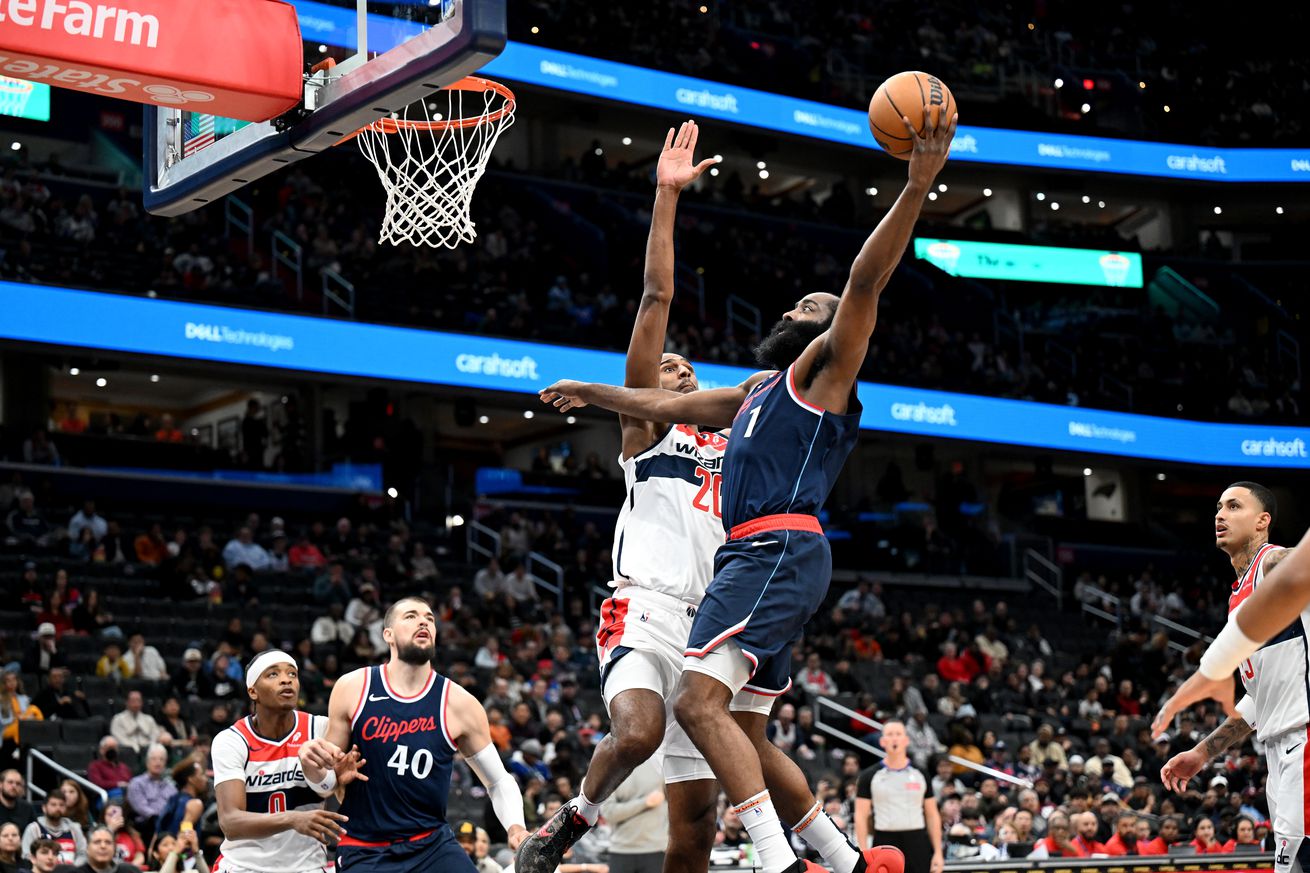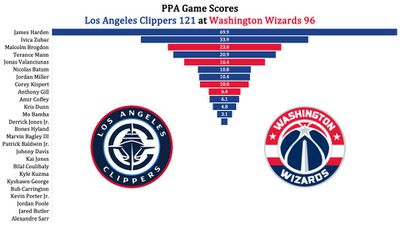
Stats, analysis, commentary.
Against the visiting Los Angeles Clippers, the Washington Wizards never led, trailed by as much as 33, and lost by a final margin of 25. It was their sixth loss of 20 or more points so far this season. They have two other defeats of 19 points. Only one of their 15 defeats was by less than double digits. It was a 9-point loss to the San Antonio Spurs.
Last night was the team’s 13th straight defeat, which ties for the third longest in franchise history. The two other teams to lose 13 in a row: the 1966-67 Baltimore Bullets, and the 1994-95 Washington Bullets.
That 1966-67 team employed three head coaches — Mike Farmer, 1-8; Buddy Jeannette, 3-13; and Gene Shue, 16-40. Their best player was Gus Johnson. They finished the season 20-61 and secured the second overall pick in the draft, which they used to select Earl Monroe. They improved to 38 wins the subsequent season and got the second overall pick again. This time they took Wes Unseld and became contenders for the next decade.
The 1994-95 squad, coached by Jim Lynam, included an early season trade to acquire 21-year-old Chris Webber from the Golden State Warriors. Webber was joined on the roster by 21-year-old (and former college teammate) Juwan Howard, as well as Calbert Cheaney, Scott Skiles, and second year big man Gheorge Muresan. Their crummy record got them the fourth overall pick, which they used on North Carolina’s Rasheed Wallace…who they then traded for Rod Strickland when Howard signed a free agent contract with the Miami Heat.
The franchise record for longest losing streak stands at 16, which they’ve done twice, including once last season. We’ll look closer at those squads if (when?) this year’s team gets there.
By the way, if the Wizards’ losing streak hits 15, they’d have a winning percentage of 10.5%, which would be the worst in league history. The current “record” holder is the 2011-12 Charlotte Bobcats, which went 7-59 and had a winning percentage of 10.6%.
Last night against the Clippers, the Wizards gave ample demonstration of their two biggest flaws: they can’t score, and they can’t stop the opponent from scoring. At the risk of getting too technical, that’s not a good combination.
Forward Kyle Kuzma left the game after eight minutes due to a rib sprain. The team has not yet said whether he’ll miss any upcoming games or be limited.
As former Wizards assistant coach Dean Oliver wrote in his book Basketball on Paper, there are four factors that determine who wins and loses in basketball. Last night, the Wizards lost all four — the Clippers shot better, got more offensive rebounds, committed fewer turnovers, and had more free throws.
Bright spots?
- Malcolm Brogdon gave the kind of efficient performance that could help convince a contending team to give up a first round pick to acquire him and bolster their backcourt.
- Jonas Valanciunas gave the kind of efficient performance that could help convince a contending team to give up a first round pick to acquire him and bolster their frontcourt.
- Bilal Coulibaly got a thorough schooling in basketball craft from James Harden, who was sensational.
That’s about it, and I confess that I stretched to get to those three. I mean, Harden scored 43 points on 22 shots in 32 minutes. Big man Ivica Zubac dominated the paint with 18 points and 16 rebounds on just 11 shots and in 24 minutes. Terance Mann had four assists and four steals.
Will the Wizards actually set a new mark for consecutive futility? A quick look at the schedule suggests it could reach 19 before they have a reasonable shot at winning:
- at Milwaukee Bucks
- at Cleveland Cavaliers
- vs. Dallas Mavericks
- vs. Denver Nuggets
- vs. Memphis Grizzlies
- vs. Charlotte Hornets
That would get them to 18 consecutive losses. If they drop that one to Charlotte, the streak could go epic — perhaps getting to 24 before they have three straight theoretically winnable games starting January 1. This could get ugly.
Four Factors
Below are the four factors that decide wins and losses in basketball — shooting (efg), rebounding (offensive rebounds), ball handling (turnovers), fouling (free throws made).
Stats & Metrics
Below are a few performance metrics, including the Player Production Average (PPA) Game Score. PPA is my overall production metric, which credits players for things they do that help a team win (scoring, rebounding, playmaking, defending) and dings them for things that hurt (missed shots, turnovers, bad defense, fouls).
Game Score (GmSC) converts individual production into points on the scoreboard. The scale is the same as points and reflects each player’s total contributions for the game. The lowest possible GmSC is zero.
PPA is a per possession metric designed for larger data sets. In small sample sizes, the numbers can get weird. In PPA, 100 is average, higher is better and replacement level is 45. For a single game, replacement level isn’t much use, and I reiterate the caution about small samples sometimes producing weird results.
POSS is the number of possessions each player was on the floor in this game.
ORTG = offensive rating, which is points produced per individual possessions x 100. League average last season was 114.8. Points produced is not the same as points scored. It includes the value of assists and offensive rebounds, as well as sharing credit when receiving an assist.
USG = offensive usage rate. Average is 20%.
ORTG and USG are versions of stats created by former Wizards assistant coach Dean Oliver and modified by me. ORTG is an efficiency measure that accounts for the value of shooting, offensive rebounds, assists and turnovers. USG includes shooting from the floor and free throw line, offensive rebounds, assists and turnovers.
+PTS = “Plus Points” is a measure of the points gained or lost by each player based on their efficiency in this game compared to league average efficiency on the same number of possessions. A player with an offensive rating (points produced per possession x 100) of 100 who uses 20 possessions would produce 20 points. If the league average efficiency is 114, the league — on average — would produced 22.8 points in the same 20 possessions. So, the player in this hypothetical would have a +PTS score of -2.8.
